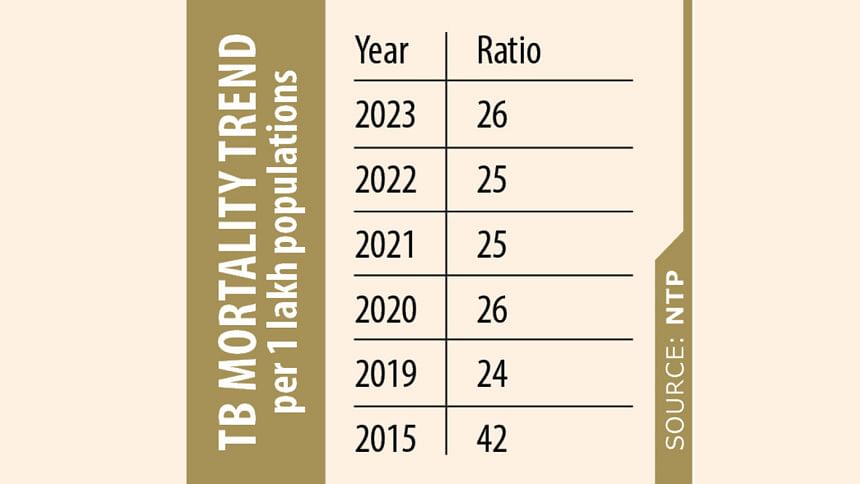Tuberculosis incidence in Bangladesh: WHO’s 2025 targets remain a far cry

Bangladesh is unlikely to meet its 2025 targets adopted under the WHO's End TB Strategy in 2015 as the country is struggling to reduce the incidence rate of the contagious bacterial disease, said officials and experts.
TB incidence rate is the number of new and relapse tuberculosis cases arising in a year, expressed as a rate per 1 lakh population.
The target for 2025 is a 50 percent reduction in tuberculosis incidence rate compared to that of 2015.
In 2015, the World Health Organisation's estimated incidence rate for all forms of tuberculosis in Bangladesh was 225 per 1 lakh population. In 2023, the estimated incidence rate was 221 per 1 lakh population, indicating very little progress here.
Surprisingly, the incidence rate (221 per 1 lakh population) remained same for six years from 2018.
Bangladesh was also supposed to reduce tuberculosis deaths by 75 percent from its 2015 number. In 2023, 44,000 died from tuberculosis, reflecting around a 60 percent decrease in the death rate.
The number of tuberculosis deaths was 73,000 in 2015.
While the authorities are yet to disclose the death toll for 2024, Bangladesh needs to bring down the deaths by at least 15 percent from its 2023 fatality tally by this year.

However, data from the National Tuberculosis Control Programme shows that the number of people detected with the disease last year increased compared to the previous year.
According to NTP, 3.13 lakh people tested positive for TB last year after around 30 lakh people with tuberculosis symptoms underwent the test. The number of patients detected in 2023 was 3.01 lakh, the data shows.
Against this backdrop, Bangladesh, one of the 30 countries with a high number of tuberculosis patients, is observing World Tuberculosis Day today. This year's theme is "A TB-free Bangladesh can be achieved through commitment, investment, and service delivery".
"We are hopeful of meeting the target regarding reducing mortality rate," said Zubaida Nasreen, line director for Tuberculosis-Leprosy and AIDS STD Programme.
She said they have started Tuberculosis Preventive Therapy from 2022. Last year, 1.77 lakh people were given the therapy.
"However, we are lagging in terms of reducing the rate. It's not possible to say now when we can achieve the target," Nasreen added.
The incidence rate is unlikely to decrease until the country can reduce the number of missing cases (undetected tuberculosis patients), said a public health expert, who asked not to be named.
The WHO estimated the number of patients to be 3.79 lakh in 2023, while 3.01 lakh patients were detected, meaning around 78,000 cases remained undetected, he said.
Once the number of missing cases is addressed, the incidence rate would start to decrease, he said.
He, however, said the number of case notifications has risen over the years.
"But still, we need to intensify efforts to detect the missing cases, and to do so, the government must invest more. Unless the missing cases are detected, they will continue to spread the disease among others," he added.
The expert said the estimation process of WHO also should be reviewed to get the actual picture.
Meanwhile, the Trump administration's abrupt suspension of the USAID programme in January has dealt a blow to Bangladesh's efforts to stave off tuberculosis.
For instance, the icddr,b's Alliance for Combating Tuberculosis, aimed at improving tuberculosis case detection by strengthening the health system, has ground to a halt after USAID stopped funding the programme.
Initiated in March 2020 with a $30 million grant, the project received a three-year extension to March 2027 with a total of $74.9 million, shows icddr,b's annual report for 2023.
The project's focus was to increase tuberculosis detection among children, drug-resistant tuberculosis patients and high-risk groups.
In 2023, ultra-portable X-ray machines with AI were introduced in remote areas under the programme with the view to enhancing tuberculosis diagnosis. A total of 47,845 individuals were screened, of which 226 were detected with tuberculosis.
The USAID funding was used for accelerating the work of the National Tuberculosis Control Programme (NTP), so the abrupt suspension is posing a major challenge, said two of its officials.
However, Nasreen begged to differ. "It would pose a little bit of challenge for them, but the impact won't be that much," she said.
Currently, the NTP operates under the health ministry and is primarily funded by the Global Fund to Fight AIDS, Tuberculosis and Malaria.
A network of 17 non-governmental organisations led by BRAC also collaborates on the programme with the Global Fund.
While the tuberculosis mortality rate has decreased, socio-economic conditions such as malnutrition, poverty, climate change and population density have seen little improvement, leaving room for the further spread of the disease, said Akramul Islam, senior director of Brac Health Programme.
Improving these socio-economic indicators remains a major challenge, he said.
"Therefore, the number of tests and the coverage of preventive measures must be expanded," he added.

 For all latest news, follow The Daily Star's Google News channel.
For all latest news, follow The Daily Star's Google News channel. 





Comments